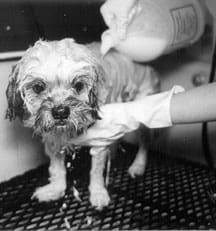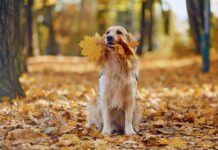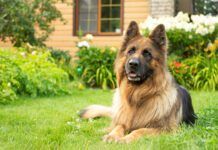[Updated August, 16, 2018]
When I was growing up, I knew a family that kept a dog just for finding and killing skunks. My friends lived on a big cattle ranch, and all their dogs had jobs. They had a couple of Australian Kelpies for working cattle, a number of tall, rangy hounds for hunting wild pigs, and then there was poor Frank, the skunk dog.
I don’t remember where my friends had obtained Frank, or even what breed of dog he was, but I recall that there had been numerous cases of rabies in the county where I lived as a child, and that skunks were the main carriers. My friends’ father routinely shot skunks when he came across one that was above ground; it was a cattle rancher’s rabies control method.
But if he found a skunk den, he’d bring Frank on the job. Frank lived to hunt and kill skunks. Tim could leave Frank at a skunk den somewhere on the ranch, and Frank would stay there until he had dug out (or out-waited) and killed every skunk around. Then he would trot home, satisfied, and utterly coated in skunky musk. “Good boy, Frank!,” Tim would tell the hard-working dog, as he fed him a hearty dinner and chained him up again, until it was time to go find some more skunks.

As my friends and I played around their ranch, we’d frequently visit the large pen where the hunting hounds were kept. We weren’t allowed to let them out or go into their pen without Tim’s permission, but we’d scratch their bony chests and stroke their long ears through the wire. It was no good trying to pet the cattle dogs; the Kelpies were all business. And petting Frank was out of the question; he was a friendly dog, and would flatten his ears and crawl toward you on his belly as far as his chain would let him, wagging his tail as hard as he could. But Frank smelled WAY too foul to get within a hundred yards of him. We’d keep our distance and croon to him instead, “Poor Frank, you’re a good dog. Sorry you smell so bad, Frank.” All the while, Frank would grovel and whine, trying hard to understand why the three little girls wouldn’t ever come pet him.
Some Dogs Just LOVE Skunks
Of course, not many of us have dogs whose sole occupation in life is to attack and kill skunks. But some of do have dogs who regard this risky task as an enjoyable hobby, much to our dismay.
The biggest danger of skunk hunting – for dogs and the people who own them – is the danger of rabies infection; skunks are the second-most common carriers of the fatal disease (see “What You Should Know About Rabies,” below).
Statistically speaking, however, the most common hazard of approaching a skunk is getting hit with a potent chemical bomb. The furry creatures, members of the weasel family, are equipped with two internal glands, located at the base of their tails, that contains a thick, volatile, oily liquid that contains highly odorous compounds called thiols, a substance also found in decomposing flesh and fecal material.
Most skunks have utter confidence in the ability of this substance to drive away predators, so they don’t usually try to evade an approaching dog. Instead, they will hiss and growl, and stamp their feet, trying to warn a dog off. If the dog keeps its distance, barking and harassing the animal, the skunk will usually retreat at a dignified pace. But an incautious dog who runs for a skunk at top speed is going to get sprayed, and the closer he managed to get to the small animal, the worse he will be coated with the oily liquid.
Getting sprayed just once teaches some dogs to avoid the striped or spotted animals, but others don’t seem to mind it a bit, even if the musk gets in their eyes and nose, temporarily blinding them and making them sneeze and choke. You’d think they’d figure out a cause-and-effect relationship between investigating that cat-like creature, the horrible smell and stinging eyes, and then the days and days of baths, but few dogs learn to connect those dots.
But it certainly makes life miserable for the owners of the dogs who enjoy skunk hunting. It’s bad enough to smell skunk spray as you drive down a freeway at 60 miles an hour; it could be qualified as torture to live in the same house as a dog who’s coated with the stinky stuff.
So the dog gets a bath – and another one, and another one, and another one. Skunk spray is notoriously difficult to wash away – even with the well-known home remedy of washing the dog with tomato juice. As many dismayed owners of skunked dogs have discovered, tomato juice often turns a light-colored dog pink, but it doesn’t begin to get rid of the skunk smell. People have tried other substances – including Fels Naptha Laundry Soap, Massengil Douche, Scope Mouthwash, white vinegar, orange juice, and vanilla extract – but none of these remedies work very well.
The Hero of Skunk Spray Relief: Paul Krebaum
Enter chemist Paul Krebaum, of Lisle, Illinois. In 1993, while working on a research project involving thiols, he formulated a compound that could change thiols into other chemicals. In simplest terms, he discovered that by making oxygen molecules bond with thiols, the smelly substances were chemically altered into odor-free neutral substances. Best of all, Krebaum’s formula was incredibly simple, composed only of hydrogen peroxide, sodium bicarbonate (baking soda), and liquid soap.
Krebaum wasn’t the first one to apply his formula to removing skunk odor, though it happened at his suggestion. A colleague at work came to the office one day, talking about a skunk encounter his cat had the night before. The man had bathed his cat with tomato juice, to no avail, and the cat was temporarily banned from his house. Apparently it is common knowledge to chemists that skunk spray is made of thiols; Krebaum immediately thought of his formula, and recommended it to his co-worker.
The man came to work the following day raving about the formula’s success; every trace of the odor was gone.
The Magic Skunk Deodorizing Formula
Has Krebaum gone on to fame and fortune as a result of his discovery? Sadly, no. The oxygen-producing formula can not be bottled; it would explode any bottle you tried to put it in. Instead, the chemist decided to make his formula a gift to humanity. Here is the recipe (it can be mixed in larger amounts, if needed, to wash a big dog):
1 quart 3% hydrogen peroxide
1/4 cup baking soda
1 teaspoon liquid soap (Dawn dishwashing detergent is often recommended, though any dish soap will work)
Mix in a bucket or bowl; it will be fizzy, a clue that you shouldn’t try to mix it or store it in a bottle or other closed container. Thoroughly wet your dog with the solution. Knead it well into his coat, to chemically alter every bit of the thiols on his hair. Be careful to keep formula out of the dog’s eyes, nose, and mouth; you can use a sponge to carefully wipe it onto his face. Follow the bath with a thorough rinse.
This formula came along too late for poor Frank, the professional skunk dog, but it could keep your dog out of the doghouse, and in your house, where he belongs!
What You Should Know About Rabies
No other animal disease is as widely known or as widely feared as rabies. Part of the reason for this fearsome reputation is the disease’s fatality rate: by the time that the first symptoms appear in a patient, the only opportunity for saving his life is already long gone.
Rabies is caused by the Lyssavirus (the word lyss is Greek for “madness” or “rage”); and any mammal (including humans) is susceptible. The rabies virus, found in infected animals’ salivary glands, is transmitted only through saliva. Other bodily fluids, including blood, urine, and skunk spray, do not contain the virus. The method of transmission usually is a skin-penetrating bite, but any contact with an infected animal’s mucous membranes will suffice. A veterinarian should suspect rabies in a canine patient if the dog has had any known encounters with a wild animal in the past six months.
Fear reigns when such a potent killer is in the area. But rabies can be transmitted to a dog only if the virus is introduced from an infected animal’s saliva into an unvaccinated or improperly vaccinated dog’s bite wounds, open cuts in skin, or onto mucous membranes. Because the virus is easily killed with soap and water, the very first recommendation for any person or any dog who is bitten by any animal is to wash the wound very thoroughly with soap and water.
Most veterinarians – holistic and otherwise – recommend the use of rabies vaccine for animals living in areas where rabies is well established in the local wild animal population. This protects the dog, of course, but the reason that all states require rabies vaccinations (anually, in some states, and every three years in others) is to reduce the chances of an infected dog infecting people.
Titer tests of vaccinated dogs indicates that the protection can last much longer than three years, but whether administration of the rabies vaccine can be safely reduced is a matter of opinion. Public health officials would prefer to see all animals vaccinated annually. For obvious reasons (sales), so would vaccine makers. Many veterinarians share the vaccine industry’s confidence in the products (and perhaps, interest in profits), and have no qualms about recommending annual boosters.
A small but growing number of veterinarians, however, are questioning the need for annual (or even triennial) rabies boosters, even in areas where rabies is endemic. Sharpening their point is the fact that there has never been a case of a dog that was vaccinated against rabies two or more times contracting the disease, unless the animal was immunosuppressed.






